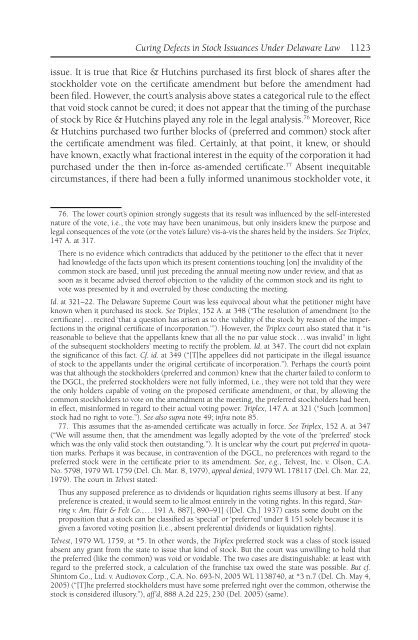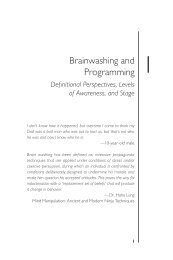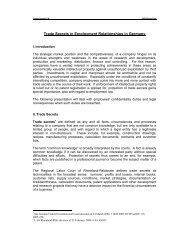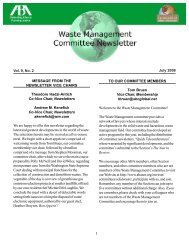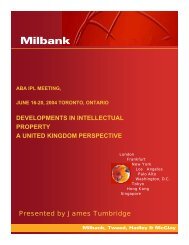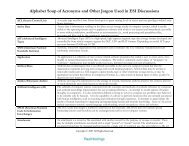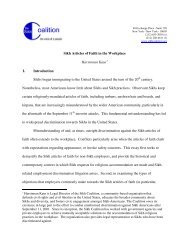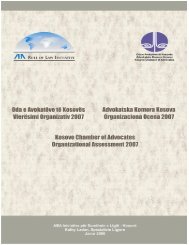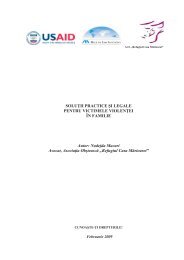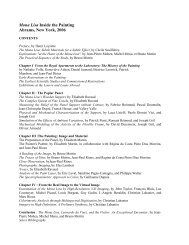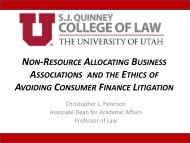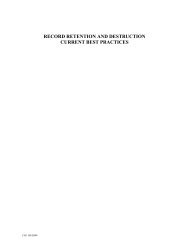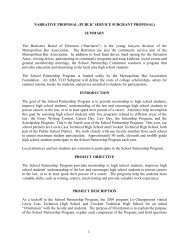Curing Defects in Stock Issuances - American Bar Association
Curing Defects in Stock Issuances - American Bar Association
Curing Defects in Stock Issuances - American Bar Association
Create successful ePaper yourself
Turn your PDF publications into a flip-book with our unique Google optimized e-Paper software.
<strong>Cur<strong>in</strong>g</strong> <strong>Defects</strong> <strong>in</strong> <strong>Stock</strong> <strong>Issuances</strong> Under Delaware Law 1123<br />
issue. It is true that Rice & Hutch<strong>in</strong>s purchased its fi rst block of shares after the<br />
stockholder vote on the certifi cate amendment but before the amendment had<br />
been fi led. However, the court’s analysis above states a categorical rule to the effect<br />
that void stock cannot be cured; it does not appear that the tim<strong>in</strong>g of the purchase<br />
of stock by Rice & Hutch<strong>in</strong>s played any role <strong>in</strong> the legal analysis. 76 Moreover, Rice<br />
& Hutch<strong>in</strong>s purchased two further blocks of (preferred and common) stock after<br />
the certifi cate amendment was fi led. Certa<strong>in</strong>ly, at that po<strong>in</strong>t, it knew, or should<br />
have known, exactly what fractional <strong>in</strong>terest <strong>in</strong> the equity of the corporation it had<br />
purchased under the then <strong>in</strong>-force as-amended certifi cate. 77 Absent <strong>in</strong>equitable<br />
circumstances, if there had been a fully <strong>in</strong>formed unanimous stockholder vote, it<br />
76. The lower court’s op<strong>in</strong>ion strongly suggests that its result was <strong>in</strong>fl uenced by the self-<strong>in</strong>terested<br />
nature of the vote, i.e., the vote may have been unanimous, but only <strong>in</strong>siders knew the purpose and<br />
legal consequences of the vote (or the vote’s failure) vis-à-vis the shares held by the <strong>in</strong>siders. See Triplex,<br />
147 A. at 317.<br />
There is no evidence which contradicts that adduced by the petitioner to the effect that it never<br />
had knowledge of the facts upon which its present contentions touch<strong>in</strong>g [on] the <strong>in</strong>validity of the<br />
common stock are based, until just preced<strong>in</strong>g the annual meet<strong>in</strong>g now under review, and that as<br />
soon as it became advised thereof objection to the validity of the common stock and its right to<br />
vote was presented by it and overruled by those conduct<strong>in</strong>g the meet<strong>in</strong>g.<br />
Id. at 321–22. The Delaware Supreme Court was less equivocal about what the petitioner might have<br />
known when it purchased its stock. See Triplex, 152 A. at 348 (“The resolution of amendment [to the<br />
certifi cate] . . . recited ‘that a question has arisen as to the validity of the stock by reason of the imperfections<br />
<strong>in</strong> the orig<strong>in</strong>al certifi cate of <strong>in</strong>corporation.’ ”). However, the Triplex court also stated that it “is<br />
reasonable to believe that the appellants knew that all the no par value stock . . . was <strong>in</strong>valid” <strong>in</strong> light<br />
of the subsequent stockholders’ meet<strong>in</strong>g to rectify the problem. Id. at 347. The court did not expla<strong>in</strong><br />
the signifi cance of this fact. Cf. id. at 349 (“[T]he appellees did not participate <strong>in</strong> the illegal issuance<br />
of stock to the appellants under the orig<strong>in</strong>al certifi cate of <strong>in</strong>corporation.”). Perhaps the court’s po<strong>in</strong>t<br />
was that although the stockholders (preferred and common) knew that the charter failed to conform to<br />
the DGCL, the preferred stockholders were not fully <strong>in</strong>formed, i.e., they were not told that they were<br />
the only holders capable of vot<strong>in</strong>g on the proposed certifi cate amendment, or that, by allow<strong>in</strong>g the<br />
common stockholders to vote on the amendment at the meet<strong>in</strong>g, the preferred stockholders had been,<br />
<strong>in</strong> effect, mis<strong>in</strong>formed <strong>in</strong> regard to their actual vot<strong>in</strong>g power. Triplex, 147 A. at 321 (“Such [common]<br />
stock had no right to vote.”). See also supra note 49; <strong>in</strong>fra note 85.<br />
77. This assumes that the as-amended certifi cate was actually <strong>in</strong> force. See Triplex, 152 A. at 347<br />
(“We will assume then, that the amendment was legally adopted by the vote of the ‘preferred’ stock<br />
which was the only valid stock then outstand<strong>in</strong>g.”). It is unclear why the court put preferred <strong>in</strong> quotation<br />
marks. Perhaps it was because, <strong>in</strong> contravention of the DGCL, no preferences with regard to the<br />
preferred stock were <strong>in</strong> the certifi cate prior to its amendment. See, e.g., Telvest, Inc. v. Olson, C.A.<br />
No. 5798, 1979 WL 1759 (Del. Ch. Mar. 8, 1979), appeal denied, 1979 WL 178117 (Del. Ch. Mar. 22,<br />
1979). The court <strong>in</strong> Telvest stated:<br />
Thus any supposed preference as to dividends or liquidation rights seems illusory at best. If any<br />
preference is created, it would seem to lie almost entirely <strong>in</strong> the vot<strong>in</strong>g rights. In this regard, Starr<strong>in</strong>g<br />
v. Am. Hair & Felt Co., . . . 191 A. 887[, 890–91] ([Del. Ch.] 1937) casts some doubt on the<br />
proposition that a stock can be classifi ed as ‘special’ or ‘preferred’ under § 151 solely because it is<br />
given a favored vot<strong>in</strong>g position [i.e., absent preferential dividends or liquidation rights].<br />
Telvest, 1979 WL 1759, at *5. In other words, the Triplex preferred stock was a class of stock issued<br />
absent any grant from the state to issue that k<strong>in</strong>d of stock. But the court was unwill<strong>in</strong>g to hold that<br />
the preferred (like the common) was void or voidable. The two cases are dist<strong>in</strong>guishable: at least with<br />
regard to the preferred stock, a calculation of the franchise tax owed the state was possible. But cf.<br />
Sh<strong>in</strong>tom Co., Ltd. v. Audiovox Corp., C.A. No. 693-N, 2005 WL 1138740, at *3 n.7 (Del. Ch. May 4,<br />
2005) (“[T]he preferred stockholders must have some preferred right over the common, otherwise the<br />
stock is considered illusory.”), aff’d, 888 A.2d 225, 230 (Del. 2005) (same).


